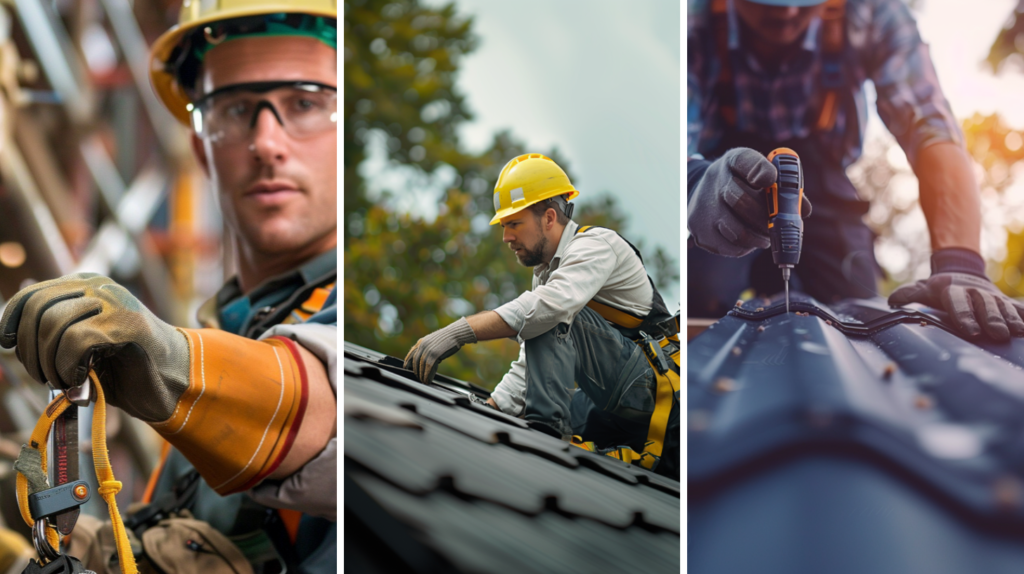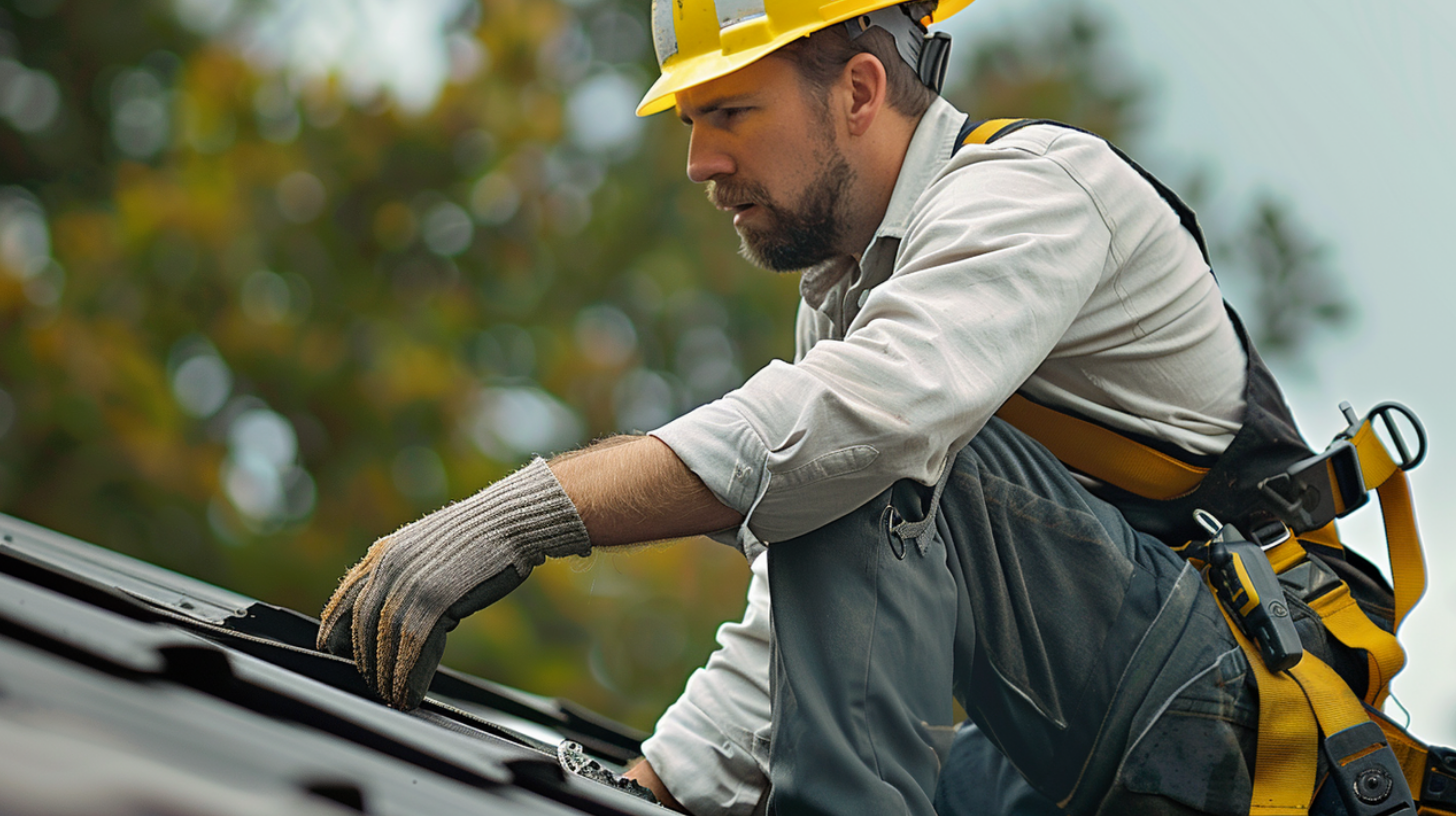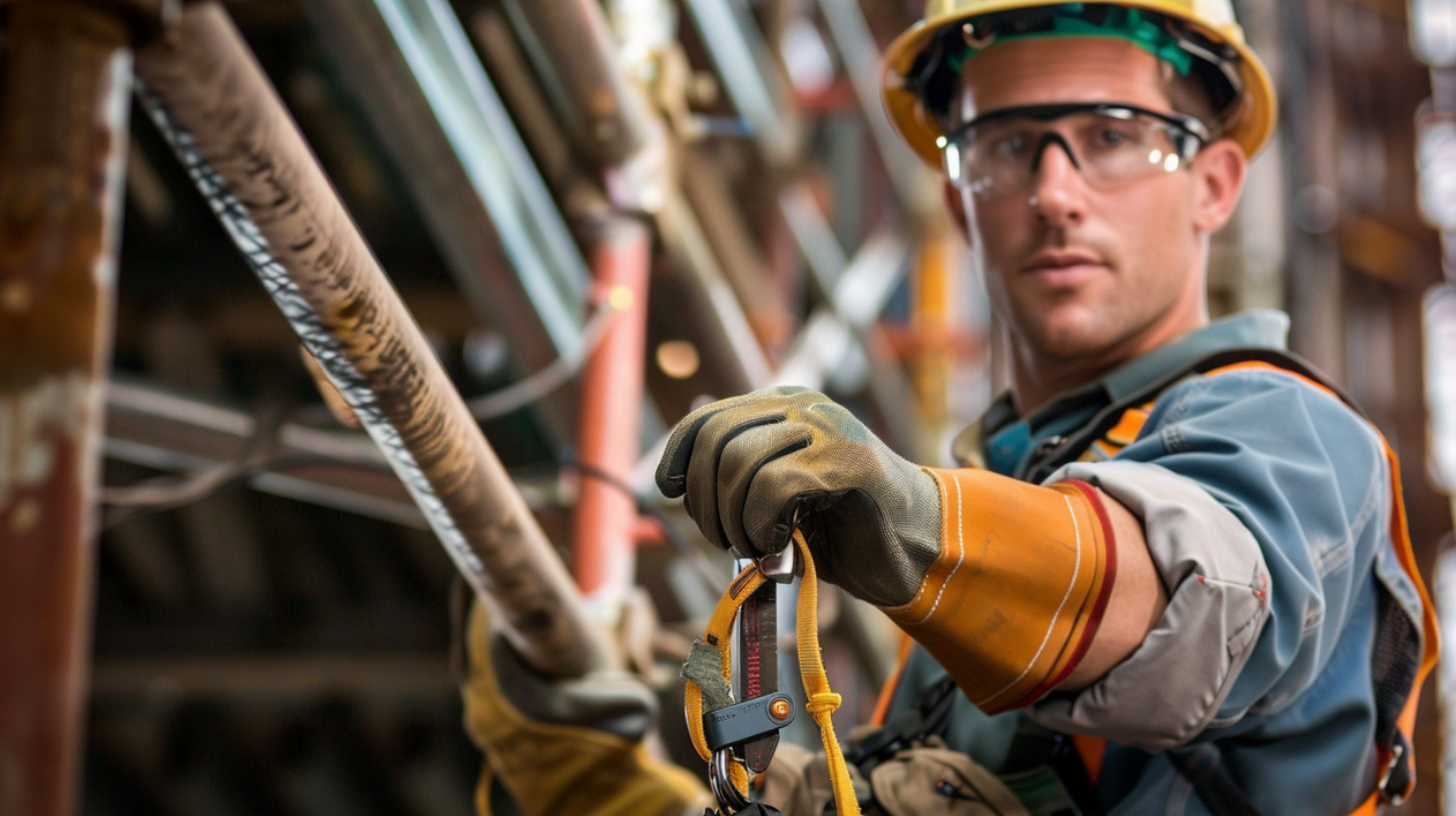Showing all posts tagged "Roofing"
Gloves - Types of Gloves - Sky Roofing Construction & Remodeling

Posted on June 18th, 2024
Gloves - Sky Roofing Construction & Remodeling - Call (210) 942-9797
Watch video on YouTube here: https://www.youtube.com/watch?v=a327Z85WHFY
via Sky Roofing Construction & Remodeling
Posted on June 18th, 2024
Gloves - Sky Roofing Construction & Remodeling - Call (210) 942-9797
Watch video on YouTube here: https://www.youtube.com/watch?v=a327Z85WHFY
via Sky Roofing Construction & Remodeling
Posted on June 18th, 2024
The Role of Gloves in Ensuring Safety in Roofing and Construction

An Introduction to Gloves
Various gloves are available, each designed to meet different requirements. For instance, leather gloves are known for their durability and robustness, making them ideal for heavy-duty tasks. The softness of touch offered by specific gloves is also crucial for tasks that require precision and sensitivity. A protective glove is essential for shielding hands from potential hazards, while a freezer glove is specifically designed to keep hands warm and functional in extremely cold conditions. By considering these factors, you can select the most appropriate gloves for your specific needs, ensuring safety and efficiency in your work.
History of Gloves
One of the earliest depictions of gloves can be found in ancient Egyptian tombs. These gloves were not only used for protection but also held symbolic meaning, representing social status and power. The Egyptians understood the practicality of hand coverings for manual labor and ceremonial purposes.
In medieval times, gloves grew in importance, particularly in warfare. Gauntlets, a glove covering the fingers and forearm, were essential for knights and soldiers. These gloves protected close combat and were often adorned with intricate designs, showcasing the wearer’s wealth and status.
Interestingly, gloves also had a noteworthy place in fashion trends throughout history. Different periods saw unique styles and materials for gloves, reflecting the prevailing fashion sensibilities. From delicate lace gloves in the Renaissance era to long opera gloves in the Victorian era, gloves became a fashionable accessory, adding elegance and sophistication to outfits.
Most glove styles evolved to meet specific needs and functions, demonstrating adaptability and relevance in various contexts. The historical development of gloves showcases their versatility and significance in different contexts. From ancient Egyptian tombs to medieval warfare and fashion trends, gloves have served various purposes throughout history, highlighting their importance and utility in multiple applications.

Gloves - Types of Gloves - Sky Roofing Construction & Remodeling
Types of Gloves
Most glove styles are designed to meet specific safety requirements, ensuring workers have the protection they need for their tasks. A protective glove is essential for shielding hands from potential hazards such as cuts, abrasions, and punctures, which are common in construction settings. Additionally, the softness of touch provided by some gloves is crucial for tasks that require skill and precision, enabling workers to handle tools and materials more effectively.
By selecting the appropriate gloves, employers can significantly enhance the safety and efficiency of their workforce. Ensuring workers have access to the proper protective gear reduces the risk of injuries. It boosts overall productivity, making the job site a safer and more efficient environment for everyone involved. Here are the gloves commonly used in roofing and construction, highlighting their benefits and advantages:
Leather Gloves
Common types of leather gloves include those made from cow, sheep, goat, and pig leather. Cow leather is known for its toughness and resistance to abrasion, while sheep leather offers flexibility and a soft texture. Goat leather is considered both durable and comfortable, and pig leather is known for its affordability and breathability.
Various glove styles are available within the leather category, each tailored to specific tasks and preferences. These styles range from heavy-duty gloves designed for intense labor to more refined ones used for precision tasks.
Leather gloves’ key features and advantages are their ability to conform to the wearer’s hand over time. This means that as you continue to wear them, the gloves mold to the shape of your hand, providing a comfortable fit. However, it is important to note that wear spots and creases may appear during the breaking-in process. Taking proper precautions to prevent excessive damage is crucial, such as inserting your hand carefully and avoiding excessive force when putting on or removing the gloves.
Another significant aspect of leather gloves is that they are a natural product. This quality contributes to their breathability and overall comfort, making them a preferred choice for many professionals who require reliable and comfortable hand protection. By understanding the different types and styles of gloves available, professionals can select the perfect pair to meet their specific needs and ensure optimal performance on the job.
String Knit Gloves
One type of string knit glove is made from cotton fibers. Cotton gloves are known for their softness, breathability, and comfort. They offer good dexterity, allowing users to easily handle objects while protecting against abrasions. Cotton gloves are commonly used in light-duty applications, such as general maintenance and material handling.
Nylon string knit gloves are another popular option. Nylon fibers provide excellent stretch and fit, making these gloves ideal for workers who require a snug and secure fit. They also offer superior resistance to abrasions and tears, protecting sharp objects and rough surfaces. These gloves are often used in assembly lines, construction, and the automotive industries.
Polyester string knit gloves are durable and possess high tensile strength. They are also resistant to chemicals, oils, and solvents, making them suitable for applications involving contact with hazardous substances. Polyester gloves are commonly used in manufacturing, chemical handling, and oil and gas.
Duty gloves made from string-knit materials are designed to provide enhanced protection and durability for more demanding tasks. These gloves are reinforced in high-wear areas, offering additional safeguarding for heavy-duty work environments.
String knit gloves offer excellent breathability, flexibility, and comfort regardless of the fiber used. They are also lightweight, allowing for increased dexterity and precision. These gloves are ideal for handling small objects, general maintenance, light construction, and gardening. Coating the glove with coatings such as latex or nitrile can further enhance its grip and protection, making it an essential safety accessory in various industries. These gloves provide workers with the protection they need while allowing for comfortable and efficient task performance.
Mechanics Gloves
Durability is one of the primary features of mechanics gloves. Built to withstand rigorous use, these gloves are often made from high-quality materials with long-lasting performance. Additionally, some mechanics gloves come with winter insulation, making them ideal for cold weather conditions, while others are designed to repel water for enhanced work capabilities even in wet environments.
For those requiring tactical capabilities in their work gloves, mechanics gloves come with features like tactical designs and camouflage patterns, ensuring that users can blend into their surroundings when necessary. Moreover, some mechanics gloves offer specialized protection, such as welding protection, cut resistance, and impact resistance, making them suitable for various industries and hazardous environments. Duty gloves, a type of mechanics gloves, are specifically engineered to handle more laborious tasks, providing enhanced durability and protection in demanding work conditions.
These technology-driven gloves provide durability, winter insulation, water resistance, tactical capabilities, welding protection, cut resistance, impact resistance, and camouflage designs. Some mechanics gloves cover the entire glove with reinforced materials to maximize safety and functionality, ensuring comprehensive protection and durability.
Choosing the right mechanics gloves can significantly enhance both safety and efficiency in the workplace. By selecting gloves that meet specific needs, workers can ensure they are well-protected and equipped to handle tasks confidently and precisely.
Chemical Gloves
Latex gloves, a commonly used chemical glove, offer excellent tactile sensitivity and flexibility. These gloves are often used in the healthcare industry, as they provide a barrier against bloodborne pathogens and other harmful substances. On the other hand, nitrile rubber gloves are known for their excellent resistance to punctures, abrasions, and chemicals. They are commonly used by police officers during crime scene investigations and by individuals working with hazardous materials, earning them the nickname "cop gloves."
Neoprene gloves are another type of chemical gloves that offer optimal protection against a wide range of chemicals and solvents. They are highly resistant to tearing and have good elasticity, making them suitable for various industries that deal with aggressive chemical substances.
For those looking for lower-priced gloves, options that still provide adequate protection without compromising safety are available. These lower-cost alternatives can be good for tasks requiring frequent glove changes or applications with unnecessary extreme protection.
Chemical gloves are designed with textured fingertips for improved grip, beaded cuffs for easy donning, and textured surfaces for enhanced dexterity. These features ensure the gloves fit securely and comfortably on the hands, providing maximum protection against hazardous substances.
Whether you are a healthcare professional, a police officer, or an individual working with hazardous materials, chemical gloves are a crucial part of your safety gear. They are designed to keep your hands safe from exposure to harmful substances, allowing you to work confidently and efficiently.
Disposable Gloves
Another popular option is nitrile gloves. Nitrile gloves offer similar benefits to latex gloves but without the risk of latex allergies. They are resistant to punctures, chemicals, and oils, making them suitable for various tasks in the roofing and construction industry. Additionally, nitrile gloves are highly durable and provide excellent protection, crucial for maintaining human health in hazardous work environments.
You can opt for vinyl gloves if latex or nitrile gloves are unsuitable. Vinyl gloves are latex-free and provide adequate protection against mild chemicals and contaminants. They are lightweight and more affordable than latex or nitrile gloves, making them a cost-effective choice for specific tasks. For those seeking even cheaper gloves, vinyl is often preferred due to its lower cost while offering necessary protection for less demanding applications.
Other disposable gloves include polyethylene gloves, commonly used for cleaning and food handling, and neoprene gloves, which offer excellent resistance against chemicals and punctures. Polyethylene gloves are handy for requiring frequent glove changes, providing an economical solution without compromising safety.

Gloves - Common Uses - Sky Roofing Construction & Remodeling
Common Uses of Gloves
One common use of gloves in the roofing and construction industry is to offer protection. These gloves act as a barrier, shielding hands against sharp objects, abrasive surfaces, and hazardous materials. Whether handling heavy tools or working with sharp roofing materials, safety gloves are an important line of defense. Many gloves feature elasticized wrists, which help secure the gloves, preventing them from slipping off and ensuring a snug fit that enhances safety.
Comfort is also a significant advantage of using safety gloves. Designed with ergonomic features and advanced materials, these gloves ensure ease of movement and flexibility without compromising protection. The gloves’ right fit, and comfort level enhance worker productivity by reducing hand fatigue and increasing overall comfort during long work hours.
Moreover, safety gloves offer health care benefits by preventing the transfer of germs and contaminants. In industries where exposure to chemicals, toxins, or irritants is common, gloves act as a preventive measure, keeping the skin and hands safe from harmful substances.
While most people associate gloves primarily with hazardous workplaces, they also serve a purpose in non-industrial sectors. For example, police officers rely on gloves to protect against potential harm and to prevent the transfer of fingerprints or DNA evidence. These specialized gloves, often called cop gloves, are designed to provide both protection and dexterity, highlighting the versatility and wide range of benefits that safety gloves offer.
Safety gloves have become an essential part of the roofing and construction industry. With their primary focus on protection, comfort, and healthcare benefits, these gloves are indispensable for workers in various sectors, ensuring their safety and well-being.

Gloves - Safety Standards - Sky Roofing Construction & Remodeling
Safety Standards
Safety gloves protect workers’ hands from injuries and accidents on-site. These gloves are specifically designed to provide a barrier between the hands and various elements, such as sharp objects, chemicals, extreme temperatures, and vibrations.
To comply with safety standards, selecting gloves that meet the specific needs and risks associated with the job is crucial. Different glove styles are available in the market, each designed for particular applications. For instance, cut-resistant gloves are ideal for tasks involving sharp tools and materials, while heat-resistant gloves are necessary for jobs involving high temperatures.
Moreover, safety gloves should be comfortable to wear and allow for dexterity to ensure workers can perform their tasks efficiently. While it may be tempting to opt for cheaper gloves to cut costs, it’s important to consider the potential impact on human health and safety. Cheaper gloves may not provide adequate protection or may have higher chromium levels, which can pose risks to human health over time.
Proper training on the correct usage, maintenance, and disposal of gloves is also essential to maximize their effectiveness and ensure worker safety.
By following safety standards and providing workers with appropriate protective gloves, construction companies can significantly reduce the risk of hand injuries and create a safer working environment for all employees.
Prioritize Safety with Sky Roofing Construction & Remodeling
Gloves are indispensable for ensuring safety and efficiency in roofing and construction projects. From leather gloves offering durability to string knit gloves providing flexibility, a wide array of options suit every need. To ensure safety on the job, selecting gloves that meet safety standards and provide the necessary protection is essential.
At Sky Roofing Construction & Remodeling (https://skyroofingconstructiontx.com), we prioritize the safety of our clients and employees above all else. Our team is dedicated to providing expert roofing solutions while adhering to the highest safety standards. If you’re planning a roofing project, don’t hesitate to contact us at (210) 942-9797 to schedule a consultation. Let us help you ensure a safe and successful project from start to finish.
The post The Role of Gloves in Ensuring Safety in Roofing and Construction appeared first on Roofing Contractor San Antonio - Sky Roofing Construction & Remodeling.
from Roofing Contractor San Antonio – Sky Roofing Construction & Remodeling https://skyroofingconstructiontx.com/gloves/
via Sky Roofing Construction & Remodeling
Posted on June 18th, 2024
Choosing Solar Tiles for Energy-Efficient Homes

Solar Tiles

Solar Tiles - Solar Energy Technology - Sky Roofing Construction & Remodeling
Overview of Solar Energy Technology
The solar industry continues to advance, with solar installations and systems becoming more efficient and accessible. Solar installers are crucial in ensuring solar tiles are correctly placed to capture maximum sunlight, even in harsh weather conditions. Additionally, solar incentives can further reduce the cost of transitioning to solar energy. The sleek designs of solar tiles enhance the aesthetic appeal of properties and contribute to the growing adoption of solar technology.
Benefits of Solar Tiles
Energy Cost Savings
Solar roof shingles cover the entire roof, offering protection from wind damage and contributing to energy independence. Industry experts highlight the durability and efficiency of these systems, which integrate seamlessly with the electric grid. With the ability to generate electricity and reduce costs, solar shingles are an attractive option for homeowners looking to invest in a renewable energy source while enjoying the benefits of reduced energy expenses. These substantial savings and incentives offset the average price of solar shingles, making them a practical choice for modern energy solutions.

Solar Tiles - Reduction in Energy Bills - Sky Roofing Construction & Remodeling
Reduction in Monthly Energy Bills
Residential solar tile installation is becoming increasingly popular as solar companies and manufacturers offer more efficient and affordable options. The average size of a solar tile system is designed to meet a household’s typical energy consumption, ensuring that most of the energy needs are met through renewable sources. Additionally, solar batteries can store excess electricity generated during peak sunlight hours, providing a reliable backup and reducing dependence on the electric grid.
With rising electricity costs, this financial advantage can be particularly appealing to those looking to cut down on their expenses while maintaining a comfortable and sustainable lifestyle. Furthermore, the cost savings associated with solar tiles can become even more significant as ongoing energy savings gradually offset the initial investment. Solar installations typically cost a certain amount per square foot, but the long-term benefits often outweigh the initial costs, making them a practical investment for the future.
ROI on Solar Tile Installation
When considering the installation of solar tiles, one critical factor that piques the interest of homeowners and businesses alike is the return on investment (ROI) that can be achieved. Investing in solar tiles provides the opportunity to generate clean and renewable energy and offers numerous financial benefits.
Solar tiles are:
• A modern alternative to traditional solar panels.
• Seamlessly integrating into the existing roofing.
• It is resulting in a more aesthetically pleasing appearance.
In addition to their visual appeal, solar tiles offer several advantages:
1. They provide a reliable and sustainable energy source, reducing reliance on non-renewable resources and decreasing electricity bills.
2. Solar tiles require minimal maintenance and have a long lifespan, contributing to long-term cost savings.
3. The installation of solar tiles may qualify for various government incentives and tax credits, further enhancing the potential ROI.
Investing in solar tiles offers a promising ROI due to several factors:
1. The electricity savings over time can be substantial, as solar tiles harness the abundant energy from the sun to power homes and businesses.
2. Excess energy generated by the solar tiles can be sold back to the grid, allowing for potential revenue generation.
3. Solar tiles can increase the value of a property, making it more attractive to potential buyers.
4. The environmental benefits of solar tiles can contribute to a positive public image and potential marketing advantages for businesses.
Environmental Impact
Additionally, solar tiles mitigate water pollution as they do not require water for their operation, unlike conventional power plants that heavily rely on water. Avoiding water-intensive energy production methods ensures the conservation of this vital resource and prevents pollution caused by discharge or leaks from power plants into water bodies. The environmental impact of roofing solar tiles is indisputable, as they promote clean air, protect biodiversity, and contribute to the conservation of water resources.

Solar Tiles - Decreased Carbon Footprint - Sky Roofing Construction & Remodeling
Decreased Carbon Footprint
Use of Renewable Energy Sources
Solar tiles, such as those made from copper indium gallium selenide or monocrystalline silicon cells, offer significant benefits and advantages. A solar roof installation with these tiles replaces regular shingles and contributes to clean energy production, reducing reliance on fossil fuels and helping combat climate change. Solar shingle products come with various power and solar shingle warranties, ensuring long-term performance and reliability.
Individuals can play a crucial role in promoting sustainability by incorporating clean energy into their properties. Solar roof installations not only enhance the aesthetic appeal of buildings but also provide a reliable and efficient source of electricity. As the demand for renewable energy continues to grow, solar shingle products represent a forward-thinking investment in a cleaner, greener future.
Aesthetic Appeal
Solar roofing options, such as those using monocrystalline cells, provide efficient energy production while maintaining an attractive appearance. These tiles can be installed on sloped and standard roofs, making them versatile for various architectural styles. An entire roof replacement with solar tiles can integrate with the current roof or completely replace regular roof shingles, ensuring a cohesive and polished look.
Roofing companies like Sky Roofing Construction & Remodeling enhance the visual appeal by incorporating an architectural shingle design. This design improves the roof’s aesthetics and adds depth and dimension to the overall look, further boosting the visual appeal of the solar tiles. Solar tiles are revolutionizing how we think about renewable energy in residential construction by offering a stylish and visually appealing alternative to traditional roofing options. By choosing a solar option, homeowners can enjoy the dual benefits of clean energy and a beautiful roof, making solar tiles an excellent investment for both the environment and home value.
Seamless Integration Into Existing Roof Design
A Variety of Colors and Styles
These solar products empower homeowners to choose options that provide energy efficiency and enhance the overall appearance of their property. For instance, solar roof panels can be integrated with concrete tile roofs, offering a seamless look that matches conventional roofing materials. Additionally, the choice of roof size and type, whether for roof solar or other solar roof products, ensures a suitable solar option for every home.
With the ability to combine sustainability with style, solar tiles offer a unique and advantageous choice for those looking to maximize the benefits of renewable energy. Homeowners can enjoy these advanced solar products’ aesthetic and environmental benefits by selecting solar tiles that complement their home’s design.
Types of Solar Tiles
1. Photovoltaic Solar Tiles: These solar tiles are designed to convert sunlight into electricity using photovoltaic cells. They are typically made from silicon, known for its ability to generate electricity when exposed to light. Photovoltaic solar tiles are durable and weather-resistant, offering any roof a sleek and modern look.
2. Solar Thermal Tiles: Solar thermal tiles, or solar water heating tiles, utilize the sun’s energy to generate hot water for domestic use or space heating. These tiles contain water pipes or tubes that absorb the sun’s heat, which is then transferred to the water circulating through them. Solar thermal tiles are an excellent option for homeowners looking to reduce their reliance on fossil fuels for water heating.
3. Hybrid Solar Tiles: Hybrid solar tiles combine photovoltaic and solar thermal technologies. These tiles generate electricity from sunlight while heating water for various household purposes. Hybrid solar tiles offer solar electricity generation and water heating benefits, making them a cost-effective and efficient solution for homeowners.
Solar Shingles
The history of solar shingles dates back to the 1970s, when they were initially developed for space exploration. However, in the early 2000s, commercial availability of solar shingles began to grow. Several companies have been involved in their production, continually improving the design and efficiency of these roof-integrated solar panels. Today, solar shingles are regarded as an innovative and sustainable solution for harnessing renewable energy while adding aesthetic value to buildings.
Thin Film Photovoltaic Cells Integrated Into Roofing Material
Solar Tiles for Sustainable Homes with Sky Roofing Construction & Remodeling
Harness the power of solar energy while enhancing your home’s aesthetic with Sky Roofing Construction & Remodeling’s solar tiles. (https://skyroofingconstructiontx.com) Our seamless installations blend cutting-edge technology with timeless design, offering energy efficiency and visual appeal. Take the first step towards a sustainable future and lower energy bills by contacting us at (210) 942-9797 today.
The post Choosing Solar Tiles for Energy-Efficient Homes appeared first on Roofing Contractor San Antonio - Sky Roofing Construction & Remodeling.
from Roofing Contractor San Antonio – Sky Roofing Construction & Remodeling https://skyroofingconstructiontx.com/solar-tiles/
via Sky Roofing Construction & Remodeling
Posted on June 17th, 2024
Solar Tiles - Solar Energy Technology - Sky Roofing Construction & Remodeling

Posted on June 17th, 2024
Solar Tiles - Reduction in Energy Bills - Sky Roofing Construction & Remodeling

Posted on June 17th, 2024
Solar Tiles - Solar Energy Technology - Sky Roofing Construction & Remodeling

Posted on June 17th, 2024
Solar Tiles - Reduction in Energy Bills - Sky Roofing Construction & Remodeling

Posted on June 17th, 2024
Solar Tiles - Decreased Carbon Footprint - Sky Roofing Construction & Remodeling

Posted on June 17th, 2024

